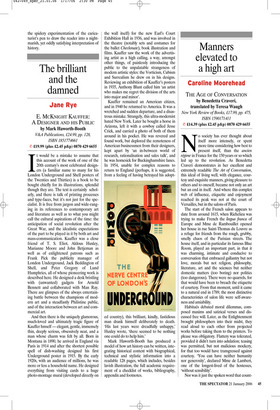The brilliant and the damned
Jane Rye
E. MCKNIGHT KAUFFER: A DESIGNER AND HIS PUBLIC by Mark Haworth-Booth V&A Publications, £24.99, pp. 128, ISBN 1851774661 ✆ £19.99 (plus £2.45 p&p) 0870 429 6655 It would be a mistake to assume that this account of the work of one of the 20th century’s most celebrated designers (a familiar name to many for his London Underground and Shell posters of the Twenties and Thirties) is a book to be bought chiefly for its illustrations, splendid though they are. The text is certainly scholarly, and there is talk of printing processes and type-faces, but it’s not just for the specialist. It is free from jargon and wide-ranging in its references to contemporary art and literature as well as to what you might call the cultural aspirations of the time: the anticipation of social revolution after the Great War, and the idealistic expectations of the part to be played in it by both art and mass-communication. Kauffer was a close friend of T. S. Eliot, Aldous Huxley, Marianne Moore and John Betjeman as well as of enlightened patrons such as Frank Pick the publicity manager of London Underground, Jack Beddington of Shell, and Peter Gregory of Lund Humphries, all of whose pioneering work is described here. He designed a desk bristling with (unwanted) gadgets for Arnold Bennett and collaborated with Man Ray. There are glimpses of the always entertaining battle between the champions of modern art and a steadfastly Philistine public, and of the interaction between art and commercial art.
And then there is the uniquely glamorous, much-loved and ultimately tragic figure of Kauffer hmself — elegant, gentle, immensely thin, deeply serious, obsessively neat, and a man whose charm was felt by all. Born in Montana in 1890, he arrived in England via Paris in 1914 and after the shortest possible spell of dish-washing designed his first Underground poster in 1915. By the early 1920s, with an audience of millions, he was more or less a household name. He designed everything from visiting cards to a huge photo-montage mural (developed directly on the wall itself) for the new Earl’s Court Exhibition Hall in 1936, and was involved in the theatre (notably sets and costumes for the ballet Checkmate), book illustration and films. Kauffer saw the work of the advertising artist as a high calling, a way, amongst other things, of painlessly introducing the public to the unpalatable strangeness of modern artistic styles: the Vorticism, Cubism and Surrealism he drew on in his designs. Reviewing an exhibition of Kauffer’s posters in 1935, Anthony Blunt called him ‘an artist who makes me regret the division of the arts into major and minor’.
Kauffer remained an American citizen, and in 1940 he returned to America. It was a wretched and sudden departure, and a disastrous mistake. Strangely, this ultra-modernist hated New York. Later he bought a horse in Arizona, left it with a cowboy called Jesse Crick, and carried a photo of both of them around in his pocket. He was revered and found work, but deplored the remoteness of American businessmen from their designers, kept apart by ‘an in-between world of research, rationalisation and sales talk’, and he was homesick for Buckinghamshire lanes. In 1954, unable for complex reasons to return to England (perhaps, it is suggested, from a feeling of having betrayed his adopt ed country), this brilliant, kindly, fastidious man drank himself deliberately to death. ‘His last years were dreadfully unhappy,’ Huxley wrote, ‘there seemed to be nothing one could do to help him.’ Mark Haworth-Booth has produced a model of how art history can be written, integrating historical context with biographical, technical and stylistic information into a readable 128 pages, which includes, besides lavish illustration, the full academic requirement of a checklist of works, bibliography, appendix and footnotes.



















































 Previous page
Previous page